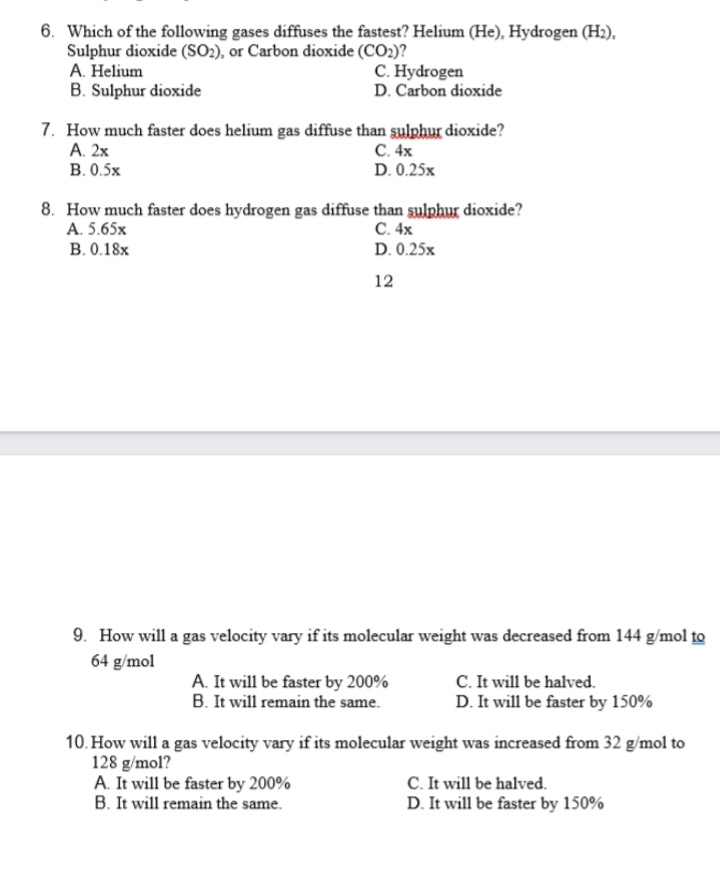Chemical, Physical and Thermal Properties of Helium - He

Chemical, physical and thermal properties of Helium - He :
(values at 25oC (77oF, 298 K) and atmospheric pressure)
| Molecular Weight | 4.0026 |
| Specific Gravity, air = 1 | 0.138 |
| Specific Volume (ft3/lb, m3/kg) | 97.86, 6.11 |
| Density of liquid at atmospheric pressure (lb/ft3, kg/m3) | 7.80, 125 |
| Absolute Viscosity (lbm/ft s, centipoises) | 13.4 10-6, 0.02 |
| Sound velocity in gas (m/s) | 1015 |
| Specific Heat - cp - (Btu/lboF or cal/goC, J/kgK) | 1.24, 5188 |
| Specific Heat Ratio - cp/cv | 1.66 |
| Gas constant - R - (ft lb/lboR, J/kgoC) | 386, 2077 |
| Thermal Conductivity (Btu/hr ft oF, W/moC) | 0.086, 0.149 |
| Boiling Point - saturation pressure 14.7 psia and 760 mm Hg - (oF, oK) | -452, 4.22 |
| Latent Heat of Evaporation at boiling point (Btu/lb, J/kg) | 10.0, 23300 |
| Critical Temperature (oF, oK) | -450.3, 5.2 |
| Critical Pressure (psia, MN/m2) | 33.22, - |
| Critical Volume (ft3/lb, m3/kg) | 0.231, 0.0144 |
| Flammable | no |
Isotope data for helium-6 in the Periodic Table Isotopes of Helium (click to see decay chain): 2 He 3 He 4 He 5 He 6 He 7 He 8 He 9 He 10 He. ››More information on molar mass and molecular weight. In chemistry, the formula weight is a quantity computed by multiplying the atomic weight (in atomic mass units) of each element in a chemical formula by the number of atoms of that element present in the formula, then adding all of these products together.
- From Wikipedia, the free encyclopedia Lithium-6 – deuterium fusion reaction: an aneutronic fusion reaction, with energy released carried by alpha particles, not neutrons. Aneutronic fusion is any form of fusion power in which very little of the energy released is carried by neutrons.
- Like most blockchains, Helium has a system of transaction fees. All transactions in the Helium blockchain are paid in Data Credits (DCs). Data Credits are produced via burning some amount of HNT using an on-chain transaction. And thanks to a system called 'Implicit Burn', users (typically) don't need to manually supply DCs to pay fees.
- Helium He Transportation Information UN Number: 1046 Shipping NameHelium,Helium, Helium, Compressed Compressed Compressed Hazard Class2.12.12.1 Label Nonflammable Nonflammable Nonflammable GasGasGas (M)SDS Reference P-4602 CAS Number 7440 - 59 - 7 General Description Colorless, odorless, nonflammable inert gas. United States of America Canada.
Follow the links below to get values for the listed properties of helium at varying pressure and temperature:

See also more about atmospheric pressure, and STP - Standard Temperature and Pressure & NTP - Normal Temperature and Pressure,
as well as Thermophysical properties of: Acetone, Acetylene, Air, Ammonia, Argon, Benzene, Butane, Carbon dioxide, Carbon monoxide, Ethane, Ethanol, Ethylene, Hydrogen, Hydrogen sulfide, Methane, Methanol, Nitrogen, Oxygen, Pentane, Propane, Toluene, Water and Heavy water, D2O.
Ust Helium 60 Shaft
Related Topics
- Material Properties - Material properties for gases, fluids and solids - densities, specific heats, viscosities and more


Is Helium-6 Radioactive
Related Documents
Helium 6 Moon
- Acetone - Thermophysical Properties - Chemical, physical and thermal properties of acetone, also called 2-propanone, dimethyl ketone and pyroacetic acid. Phase diagram included.
- Air - Thermophysical Properties - Thermal properties of air - density, viscosity, critical temperature and pressure, triple point, enthalpi and entropi, thermal conductivity and diffusicity, and more
- Benzene - Thermophysical properties - Chemical, physical and thermal properties of benzene, also called benzol. Phase diagram included.
- Carbon Dioxide Properties - Properties of saturated liquid Carbon Dioxide - CO2 - density, specific heat, kinematic viscosity, thermal conductivity and Prandtl number
- Critical Points for some Substances - Critical points of some common substances like air, argon, helium and more
- Critical Temperatures and Pressures for some Common Substances - Critical temperatures and pressures for some common substances - air, alcohol, ether, oxygen and more
- Cryogenic Fluids - or Liquefied Gas Properties - Cryogenic properties as density, boiling points and heat of evaporation for fluids like hydrogen, methane, oxygen, nitrogen, fluorine and helium
- Ethane - Thermophysical Properties - Chemical, Physical and Thermal Properties of Ethane - C2H6
- Ethylene - Thermophysical Properties - Chemical, physical and thermal properties of ethylene, also called ethene, acetene and olefiant gas. Phase diagram included.
- Gas Mixture Properties - Special care must be taken for gas mixtures when using the ideal gas law, calculating the mass, the individual gas constant or the density
- Gases - Densities - Densities and molecular weights of some common gases - acetylene, air, methane, nitrogen, oxygen and others ..
- Helium - Density and Specific Weight - Online calculator, figures and tables showing density and specific weight of helium, He, at varying temperature and pressure - Imperial and SI Units
- Hydrogen - Thermophysical Properties - Chemical, Physical and Thermal Properties of Hydrogen - H2
- Ideal Gas Law - The relations between volume, pressure, temperature and quantity of a gas, including definition of density of a gas
- Moist Air Properties - Psychrometric table with humid air properties
- Nitrogen - Enthalpy, Internal Energy and Entropy - Enthalpy, internal energy and entropy of Nitrogen as ideal gas
- Non-ideal gas - Van der Waal's Equation and Constants - Listing of van der Waals constants for more than 200 gases, used to correct for non-ideal behavior of gases caused by intermolecular forces and the volume occupied by the gas particles
- Oxygen - Enthalpy, Internal Energy and Entropy - Enthalpy, internal energy and entropy of oxygen as ideal gas
- Pentane - Thermophysical Properties - Chemical, physical and thermal properties of pentane, also called n-pentane. Phase diagram included.
- Solubility of Gases in Water - Solubility of Ammonia, Argon, Carbon Dioxide, Carbon Monoxide, Chlorine, Ethane, Ethylene, Helium, Hydrogen, Hydrogen Sulfide, Methane, Nitrogen, Oxygen and Sulfur Dioxide in water
